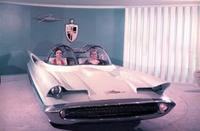By Larry Edsall
Sometimes concept cars are nothing more than astoundingly absurd flights of fancy, to explore a whimsical highway in some designer’s imagination. Other times, however, concept cars expose the very soul of a car company, as it offers up its innermost emotions and ambitions — sometimes even a glimpse of its future product lineup.
Whatever the reason for their creation, concept cars are delightful three-dimensional exercises that draw many of us to auto shows, looking for the future, or at least wondering: What were they thinking?
The following are 10 of Ford, Lincoln and Mercury’s most interesting concept vehicles from distant to recent past, with some comments on what they might have been thinking as they looked toward the future:
Lincoln Continental | |
In 1938, Henry Ford’s son, Edsel, came home from a trip to Europe eager to drive an American-made car with continental flair. Within an hour, Bob Gregorie, Ford stylist and former yacht designer, had a sketch. By the time Edsel was ready for his winter drive to Florida, so was his car, which was such a hit among the Palm Beach set that Edsel called back to Dearborn, Mich., and said he could sell 1,000 of them. The company actually sold twice that many. |  |
Lincoln Futura | |
Ford unveiled the long, low but sharply finned Futura in 1955. If this car — with its twin-bubble cockpit cover — looks familiar, it’s because Ford later sold it to Hollywood producers who converted it into the Batmobile for the 1960s "Batman" TV series. |  |
Ford Nucleon | |
In 1958, Ford built several 3/8-scale concept car models, including the Volante, which supposedly could use three fan motors to levitate from a parking place and take to the air. But the most amazing of these models was the Nucleon. What may have looked like a Continental kit sitting on the large and flat rear deck was the cover for a small nuclear reactor that would power the car through the Atomic Age. |  |
Ford Mustang | |
No, this isn’t the original pony car, though the Mustang did take its name from this concept unveiled at the 1962 U.S. Grand Prix. This Mustang marked the starting point for the development of what became the Ferrari-beating and four-time Le Mans-winning Ford GT40. |
 |
Ford Probe | |
Between 1979 and 1985, designers in Dearborn and in the Ghia studio in Europe generated a series of concepts — Probe I, II, III, IV and V — to explore aerodynamic efficiency and potential fuel economy benefits. Consider: A Mustang-sized car with sedan-like interior room and 40-plus miles per gallon. One tangible result: Probe III evolved into the Ford Sierra, a car sold briefly in the United States as the Merkur XR4Ti. |  |
Ford Synergy 2010 | |
In 1996, Ford offered its thoughts on the family car of the year 2010. The federal government got the Big Three together under the banner of the Partnership for a New Generation of Vehicles, and part of Ford’s contribution was a lightweight and aerodynamic concept vehicle designed to get 80 mpg from its 1-liter diesel-electric hybrid powertrain. |
 |
Ford GT40 | |
One of the most celebrated moments in Ford’s racing history came in the summer of 1966 when the company’s GT40 race car captured a 1-2-3 win at the Le Mans 24-hour endurance race, fulfilling Henry Ford II’s desire to beat Ferrari. The 2002 GT40 concept built on the great heritage of the nameplate, with a modern interpretation of the legendary 1960s race car that quickly went into production as the Ford GT — pace car for the entire company. |  |
Ford Model U | |
Henry Ford had his Model T. In 2003, Bill Ford had his Model U, a concept for a versatile vehicle made from environmentally friendly and renewable components such as soy-based resin and foam, and corn-based fibers. Even its hydrogen-powered hybrid powertrain used sunflower oil. |
 |
Mercury Messenger | |
In 2003, Mercury sent a Messenger to indicate the distinctive, contemporary style direction of the division's future. The Messenger was a sleek, aluminum, two-seat sports coupe that was absolutely modern, though if you squinted at it just so, it rekindled fond memories of earlier concepts such as the 1956 Cougar, 1962 Allegro, 1965 XP Bordinat Cobra and 1967 Mach 2. |  |
Ford Fairlane | |
Are we at No. 10 already? We haven’t even mentioned the Mystere or Splash, or the Indigo or Sentinel, or the Forty-Nine or 427 — not even the Shelby GR-1. But rounding out this list is none of the above, because from Woodies to Country Squires, from the Bronco to the modern sport utility vehicle, Ford has been the automotive wagon master, and the 2005 Fairlane concept pointed the way to the future of family transportation. |  |
After reading this list, you might be asking, “What was he thinking?” when he came up with this list of 10 concept vehicles. That’s fine, because that’s what concept vehicles are all about — to get us thinking.
Larry Edsall — that’s Edsall, not Edsel, and no relation to anyone named Ford — is the former managing editor of AutoWeek magazine, a freelance journalist and author of Concept Cars, Legendary Cars, Ford Racing Century and Ford GT: The Legend Comes to Life.
If you’ve suddenly gained a new interest in learning more about concept cars, you’ll find these books very interesting and informative.
Cars Detroit Never Built: Fifty Years of American Experimental Cars, by Edward Janicki (Sterling Publishing Co., New York)
Detroit Dream Cars, by John Heilig (Motorbooks/MBI Publishing Co., St. Paul MN)
American Dream Cars: 60 Years of the best Concept Vehicles, by Mitchel J. Frumkin and Phil Hall (Krause Publications, Iola, WS)




